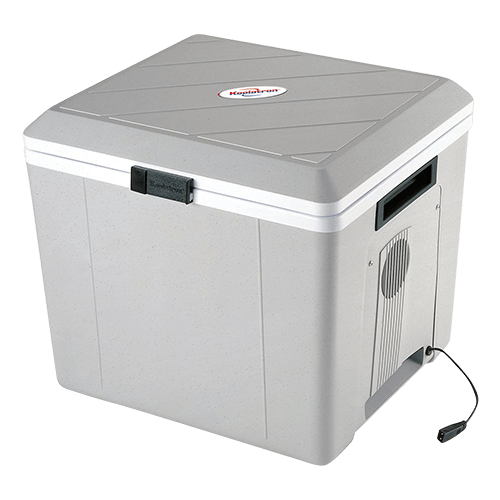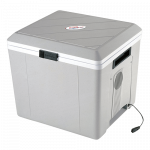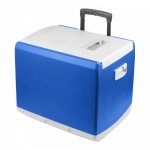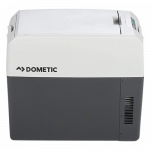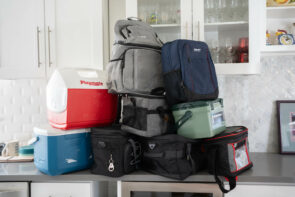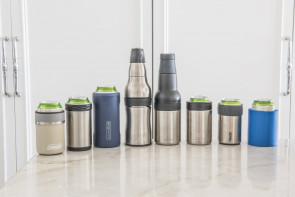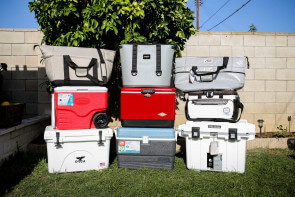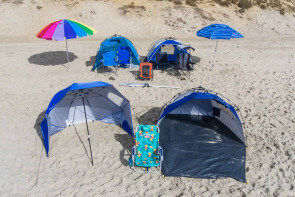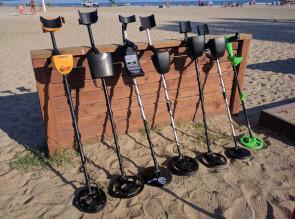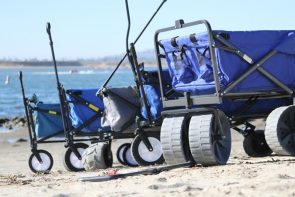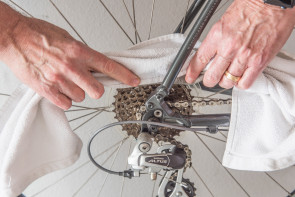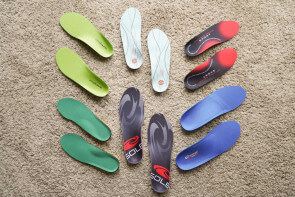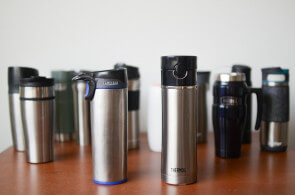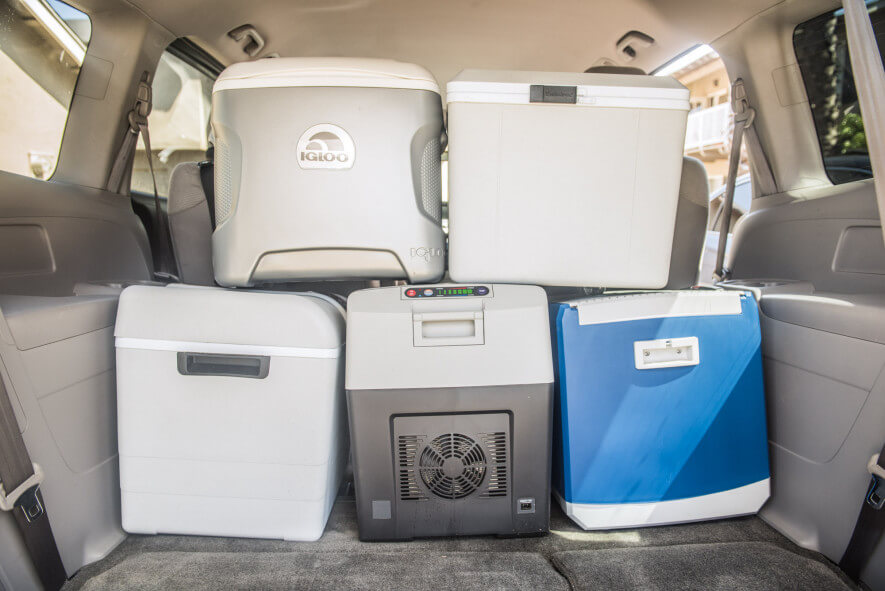
The Best Thermoelectric Coolers
After four weeks of testing five best-selling models in the summer heat, we’ve concluded that electric coolers are not actually very good at keeping things cold. If you need to keep food at a safe temperature over multiple days, check out our review of the best coolers that use ice instead of ineffective thermoelectric devices. But if you only need to keep drinks or your lunch a bit cooler while you’re driving, the 29-quart Koolatron – P27 Voyager is the best thermoelectric cooler in a disappointing lineup.
After four weeks of testing five best-selling models in the summer heat, we’ve concluded that electric coolers are not actually very good at keeping things cold. If you need to keep food at a safe temperature over multiple days, check out our review of the best coolers that use ice instead of ineffective thermoelectric devices. But if you only need to keep drinks or your lunch a bit cooler while you’re driving, the 29-quart Koolatron – P27 Voyager is the best thermoelectric cooler in a disappointing lineup.
Table of contents
- Compare the best electric coolers
- Smaller pick: Koolatron – P27
- Full-size pick: Wagan – EL6244
- The other finalists we tested
- How we selected products to test
- What is an electric cooler?
- Ice chests vs. electric coolers
- Important features to consider
- How we tested
- The bottom line
Compare the best electric coolers
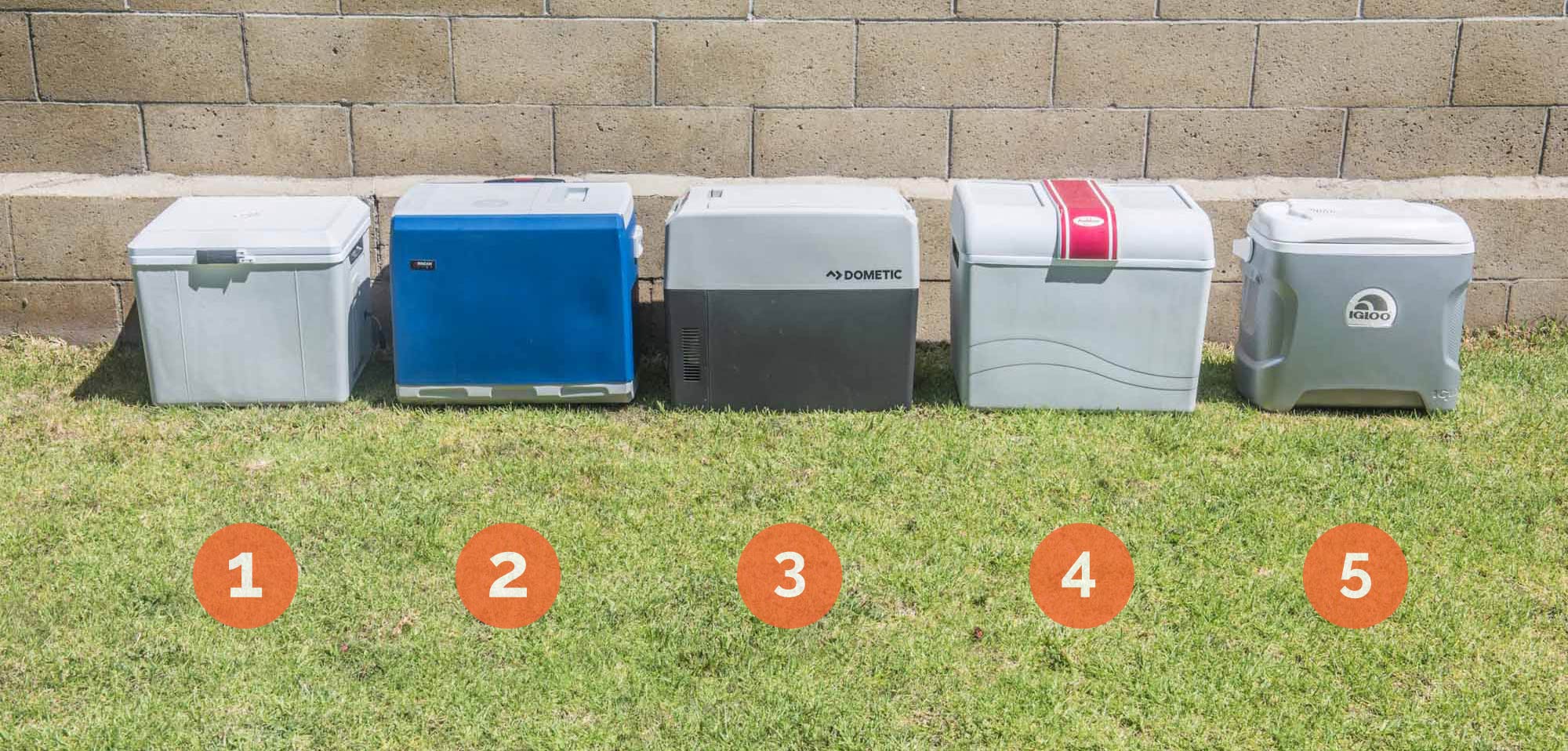
| Cooler | Price | Size (quarts) | Power Draw (amps) | Heat Mode? | Thermostat? |
|---|---|---|---|---|---|
| 1. Koolatron - P27 Voyager | $$ | 29 | 4.5 | Yes | No |
| 2. Wagan - EL6244 | $$ | 46 | 4 | Yes | No |
| 3. Dometic - TC35-DC-A | $$$$ | 35 | 3.8 | Yes | Yes |
| 4. Koolatron - P95 | $$ | 45 | 4.5 | Yes | No |
| 5. Igloo - Iceless 28 Quart | $ | 28 | 4.7 | No | No |
Smaller pick: Koolatron – P27 Voyager
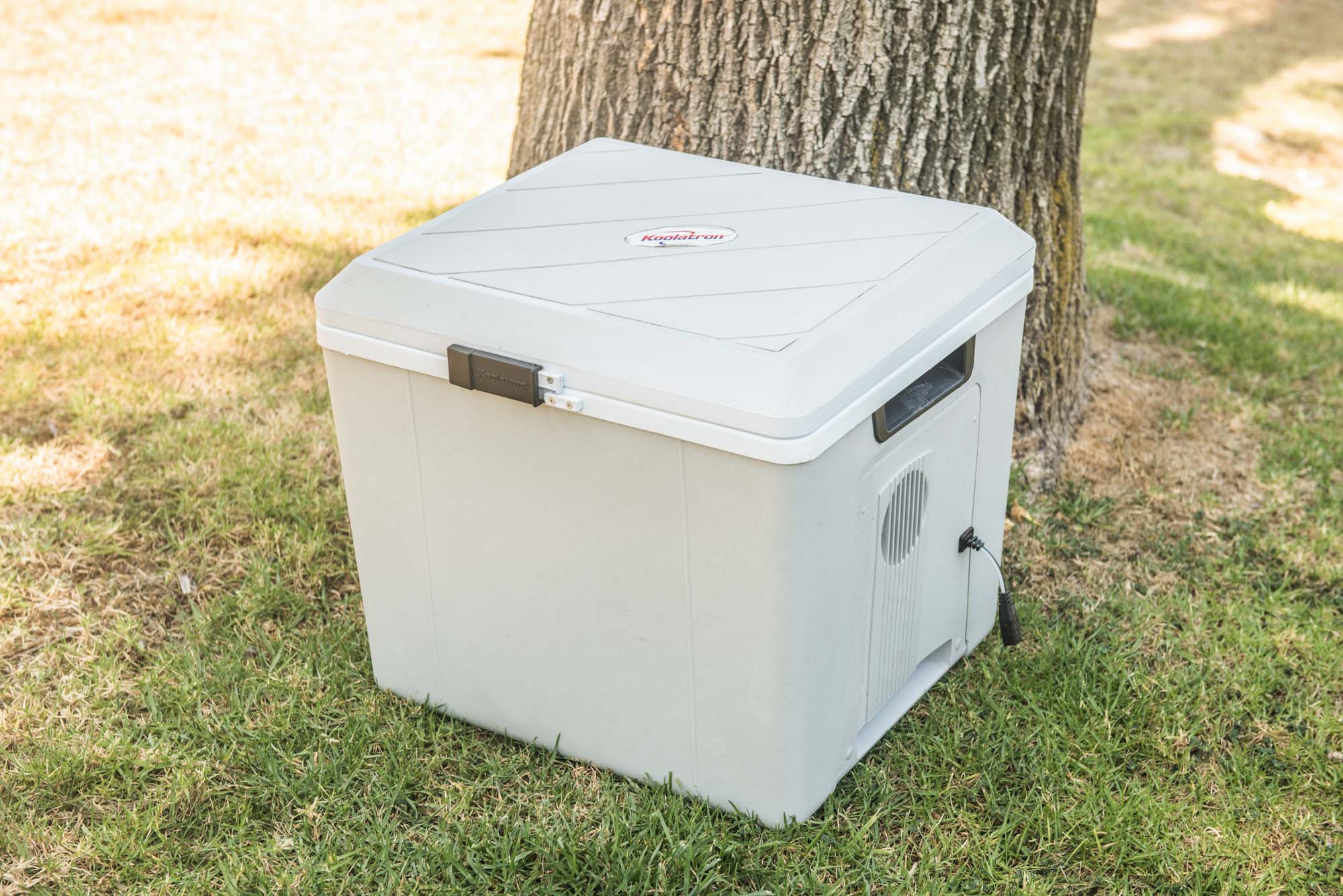
The Koolatron – P27 has the best combination of size and performance. With the best cooling performance on a 90-degree day, this 29-quart cooler will help keep your food and drinks cool.
Koolatron makes a wide range of electric cooler sizes, from a tiny six-pack chiller to a full 45-quart party cooler. We picked the P27 based on reputation among reviewers, and it didn’t disappoint. This cooler is an ideal size for family road trips, holding a two-liter bottle along with a few days’ worth of snacks.
This cooler kept coldest on hot days during our test, but it’ll still allow the contents to get up around 50 degrees sitting outside on a 100-degree day. That’s fine for chilling drinks and a packed lunch you’re going to eat the same day, but if you’ve got your vehicle parked in the sun for any amount of time it won’t keep dairy products safe.
If you do want to keep food below 40 degrees in this cooler, there are a few essential tricks you’ll need to use.
- Don’t leave the empty cooler in the car when it’s parked in the sun; take it with you so it starts out at room temperature rather than baking-hot.
- Use frozen water bottles and gel packs whenever you can to help absorb heat on a hot day. Yes, that makes this a barely-upgraded ice chest, rather than a truly iceless cooler, but it will help keep your food safe. Don’t dump ice inside or get this cooler wet, though.
- Make sure there’s some room for air to move inside the cooler and chill everything evenly. If you want to sort the items from most temperature sensitive to least sensitive, that will help too, but watch out for items sitting beside the chiller fan getting frozen.
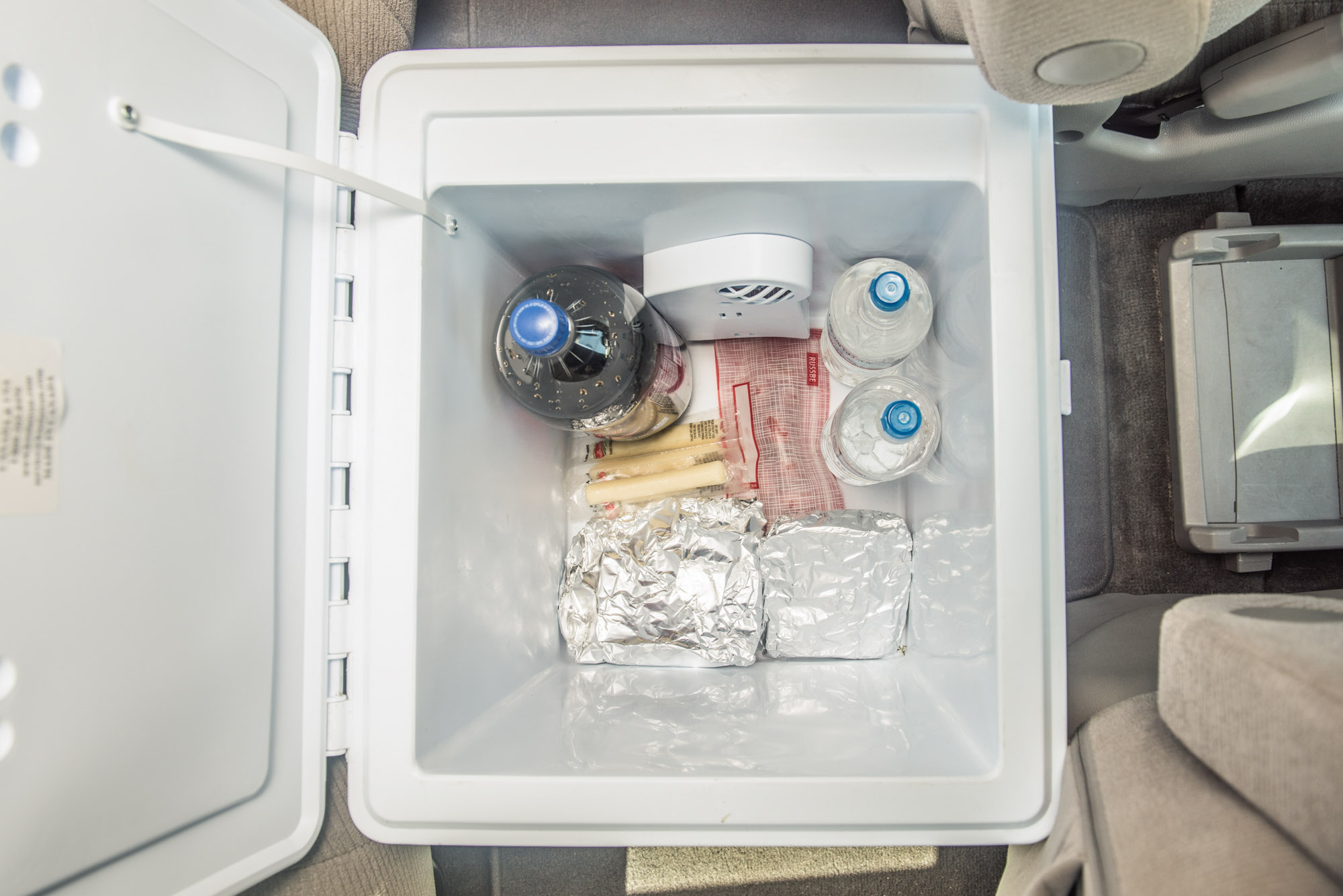
If you’re just carrying lunch and a drink every day, the 18-quart Koolatron P-20 is a better buy, since it’s slim enough to fit between the front seats of a van or truck with bucket seats. But if you’ve got room for this bigger cube-shaped cooler, it’s more versatile.
If you’re looking at buying anything bigger than the P27, you’ve got to seriously ask yourself if mediocre cooling performance will be worthwhile. Thermoelectric coolers are an excellent choice for drinks, but milk and other quick-spoiling food will need extra ice packs or some different kind of cooling solution.
One final note about quality: While we don’t have any complaints about the electronics or operation of this cooler, the Koolatron label was not applied carefully at the factory. Also, the plastic slide-lock is pretty stiff and flimsy. There was also tape residue on the side of the cooler we bought. This is a good cooler, but it’s not a shining example of quality control.
Key takeaways:
- The size and performance of the Koolatron – P27 is better than the other models we tested.
- While the Koolatron is better at cooling than the others we tested, it’s still no match for a 100-degree heat wave even when plugged in.
- This cube-shaped cooler can sit so the door opens to the side or from the top.
- For taking drinks and food on a small picnic, this is excellent.
Full-size pick: Wagan – EL6244
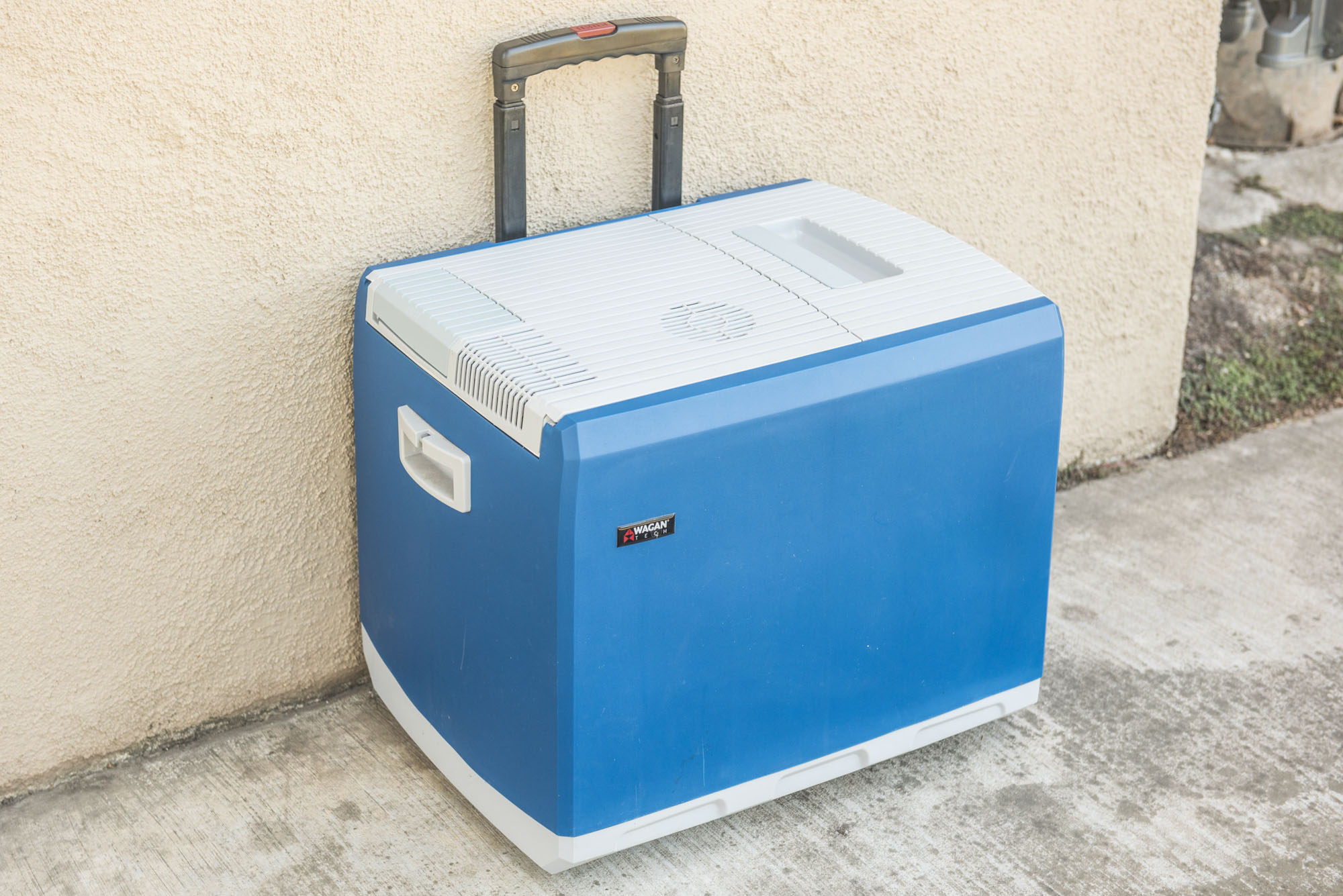
If you’re looking for a cooler that has a bit more room, the 45-quart Wagan – EL6244 has the right features and design to make the most of thermoelectric technology.
Compared to the size of the Koolatron – P27, the Wagan is just less than double the length. The lid opens in two sections, and you also get a set of wheels and an expanding handle to help cart all your drinks around.
With enough carrying capacity for two full 24-pack flats of beverage cans, this is a great cooler for tailgating. Note, however, that if you fill this cooler completely with warm beer or soda, it will probably never be able to cool them as well as it all off the way a refrigerator wcould. Always chill your food or drinks at home before you pack an electric cooler.
Like every other model we tested, the temperature spikes we measured inside this cooler during the hottest parts of the day were extreme. On a 100-degree day, the thermoelectric components can only keep the contents of this cooler at 54 degrees.
If you just want to keep your beverages at a more refreshing temperature without dealing with ice, it’ll do just fine. If you want to pack this with food and take it to a party, make sure you carefully pack the most perishable items next to a frozen water bottle or ice pack.
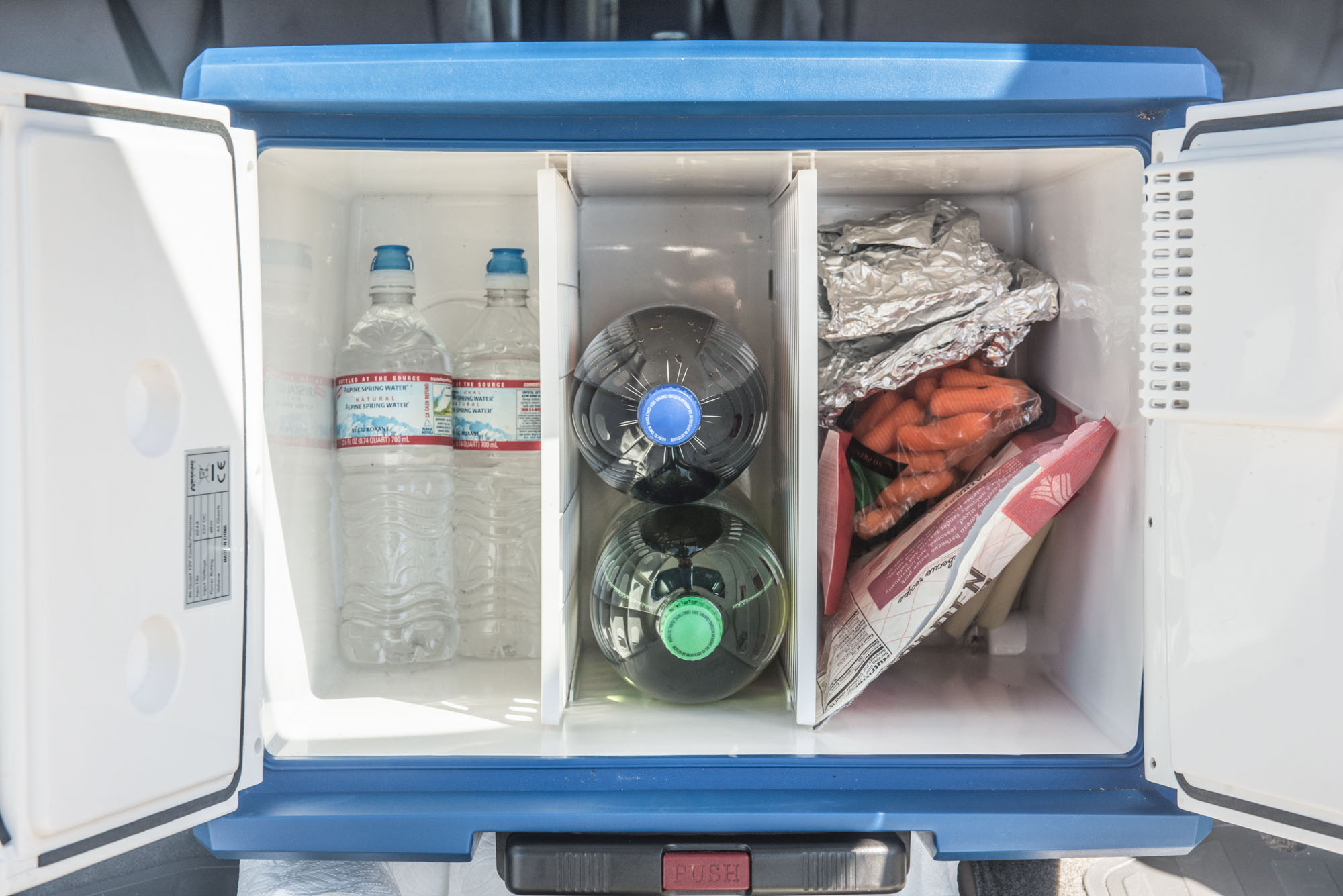
Other extra features that make this cooler stand out are removable dividers and a drain plug. The drain probably hurts insulation a bit, but it’s very nice for easy clean-out after a longer trip. The dividers make all the difference when you’re trying to keep your perishable items close to the chiller unit and want to fill up empty space with heat-absorbing frozen water bottles.
Another perk is built-in storage for the power cord: Tthe standard arrangement on most models is a little pig-tail electrical cord sticking out the side or a flush-mount socket, but Wagan tucks all the connections inside a pop-open door on the lid. The lid itself might crack if you let this cooler roll around in the back of a truck, but it keeps electrical connections safe from damage and keeps your cord from getting lost.
Despite the bigger size and extra features, the Wagan usually sells for about $15 less than the half-size Koolatron. It’s tricky to suggest that this is going to be a better pick for most people, though, since it did get 6 degrees warmer on a hot day.
Key takeaways:
- The Wagan – EL6244 is a bigger, better-equipped 45- quart cooler.
- The lower price of the Wagan reflects performance, cooling is in the middle of the pack.
- Wheels will help you move food and drinks around when you reach your perfect picnic spot.
- Internal dividers are great at keeping your food and drinks separate.
The other finalists we tested
Dometic – TC35-DC-A
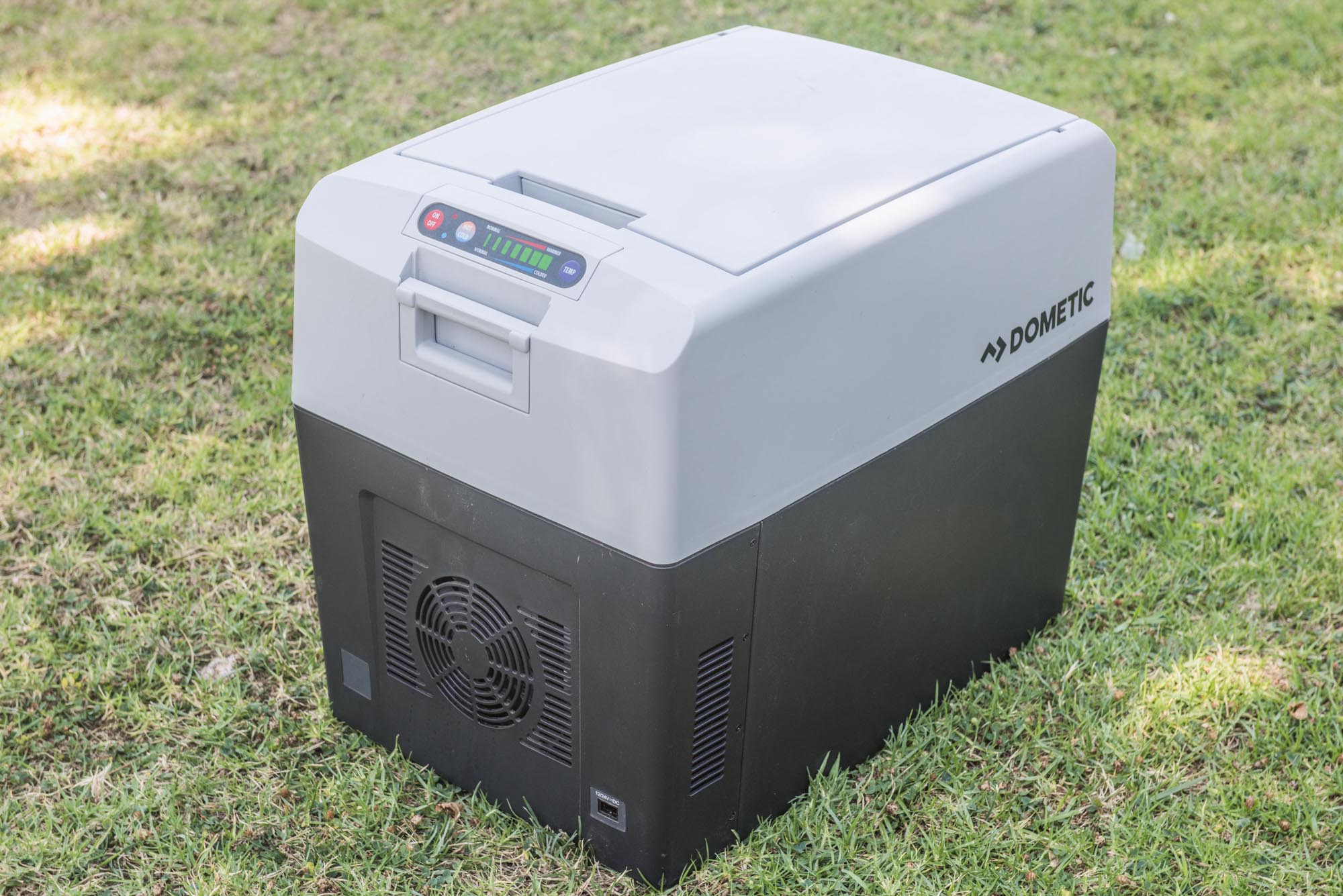
The Dometic – TC35-DC-A is a cooler with extra features that might justify its cost among a select group of buyers, but in terms of pure functionality it’s not doing much extra. The main feature to note is a thermostat, which will allow you to fine-tune the internal temperature and save power.
Dometic is well-known for their RV and trailer accessories: Ffrom fridges to air conditioners, Dometic products are all designed to make life on the road a little bit more luxurious. Compared to the full-power portable freezers Dometic sells, the TC35 is just not all that compelling despite the lower price.
The Dometic kept our lunches cooler than the Wagan, but not as cold as the Koolatron.
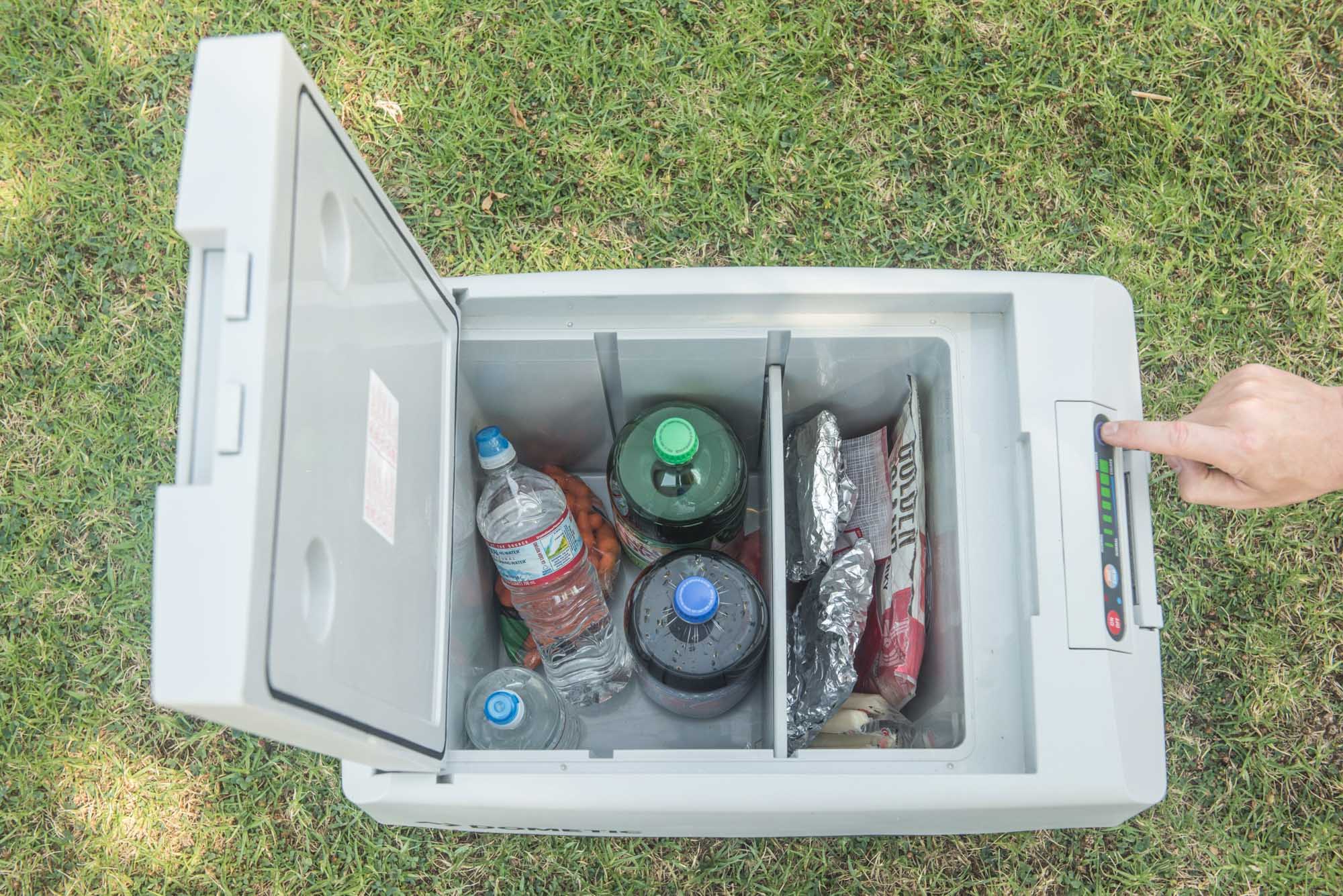
The one extra feature that separates it from the rest of this lineup is a digital thermostat: you can set a range of temperature controls to fine-tune the cold (or heat) from the thermoelectric plate.
With a seven-step range between freezing and 60 degrees Ffahrenheit when in cooling mode, this is the kind of control that might make the Dometic really useful when transporting something temperature-sensitive that can’t freeze and can’t get too hot.
That kind of control sounds great, but like a speedometer on your minivan that goes up to 300 miles per hour, it’s misleading. The ability of this cooler to hit anything below 50 degrees is dependent more on the outside temperature than on the controls.
The lid on the Dometic seals securely, which is great for insulation performance, but the spring latch is pretty stiff, and our tester accidentally left the lid cracked open during one afternoon of testing because he didn’t push down hard enough.
Dometic was the only manufacturer to include an AC 120-volt power adapter with their cooler. Cheap 5-amp adapters are easy to source, but it was a nice touch.
Dometic’s build quality is actually right in line with the higher price you’re paying, which is nice to see. Everything about this cooler is a little bit more rigid and carefully finished. Where other coolers feel like boxes of plastic with cooling modules glued to the side, this feels like a product someone set out to design.
That said, a nice-looking cooler that doesn’t keep your egg salad sandwich from spoiling on a hot day isn’t where we’d recommend spending extra money. The Wagan is just as nice to use, if you don’t need a thermostat to keep your cooler from freezing.
Koolatron – P95
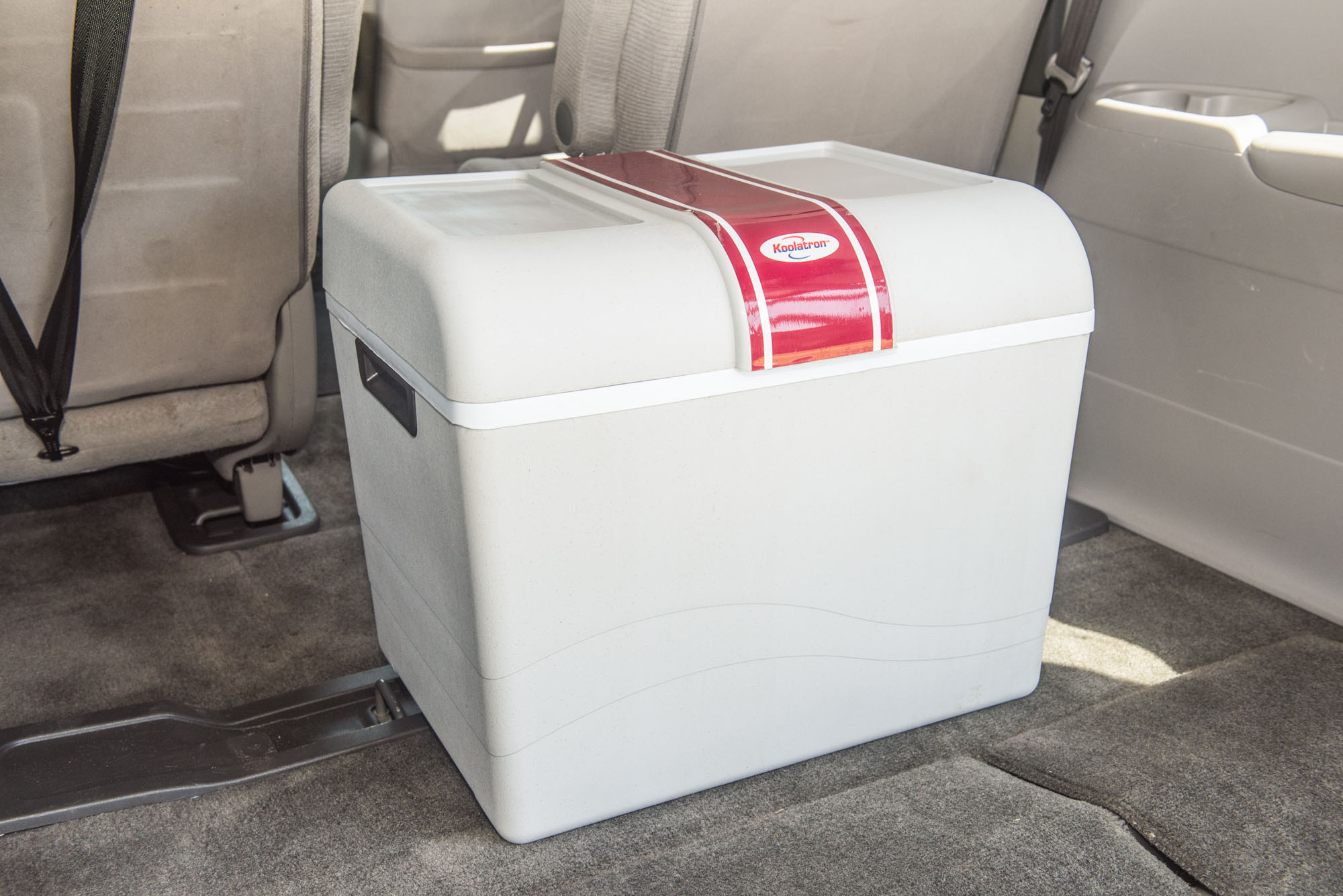
The Koolatron – P95 is a larger 45-quart version of our 29-quart top pick, and it has one nice feature that sets it apart: aA two-position shelf that keeps food and drinks organized in layers or sections for easier access. That’s especially handy if you’re using this cooler so the door opens sideways, like a fridge.
Unlike the P27, though, the P95 had terrible cooling performance. Given that it’s probably the same components in a larger box that shouldn’t be too surprising, but the other large coolers performed better.
Igloo
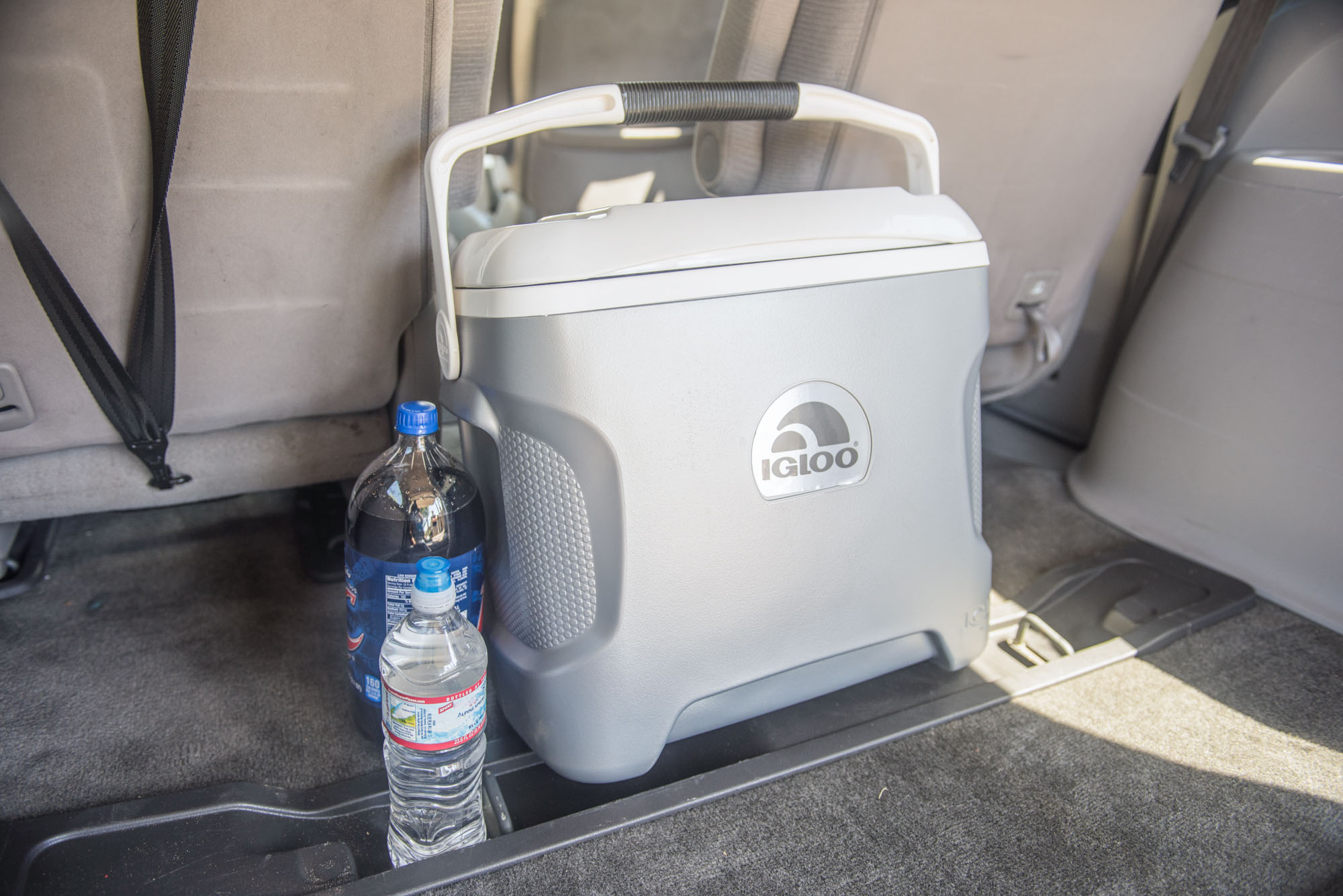
With the smallest internal capacity and the lowest price, the Igloo – Iceless 28 Quart cooler was also able to get our test lunch to the lowest temperature on an overcast summer day. The Igloo was truly freezing cold at 25.9 degrees on a 65-degree afternoon.
That performance was followed up with a flop, though, as the Igloo failed to get below 64 degrees on the following 97-degree day.
The cooling element had built up some frost during the extra-cold day that we assumed might account for some of the poor performance. Even after the frost was thoroughly melted the next day it was clear that the Igloo just didn’t have the insulation to keep its cool.
If your requirements are flexible and you just want a cheap cooler, the Igloo is not a bad design overall, with a useful carry handle and a good-looking exterior. Don’t set anything heavy on the lid, though, or the head-dissipating fan inside will start to rub on the plastic shroud.
The Igloo is the only cooler that we tested which fits comfortably between the front seats of our tester’s minivan, but that’s not enough to make it a good buy. After thorough testing, we’d check out the small coolers from Wagan before we’d settle on the Igloo for this role.
How we selected products to test
After searching for reviews, we found that only a few sites have really compared and tested electric coolers. We relied on the comparison from OutdoorGearLab to set our expectations, which is to say we realized that many buyers aren’t happy with these coolers.
We searched for coolers that customers liked most, and found a set of five with fairly good reviews and a similar set of features. We wanted to compare with a 45-quart ice-filled cooler from our cooler review, so we settled on that size as a baseline.
We specifically looked for an upgraded or higher-tier cooler to compare with mainstream models, and settled on the Dometic – TC35-DC-A because of its thermostat control. Dometic isn’t the only company selling a model like this, but they have a good reputation among RV and van enthusiasts.
We also bought two smaller coolers with high review counts — the Koolatron – P27 Voyager and Igloo – Iceless 28 Quart — that we could use as a comparison for the effect of cooler capacity on cooling performance. For your standard, insulated, non-plugin coolers, check out our review of soft and hard small coolers and larger capacity coolers.
What is an electric cooler?
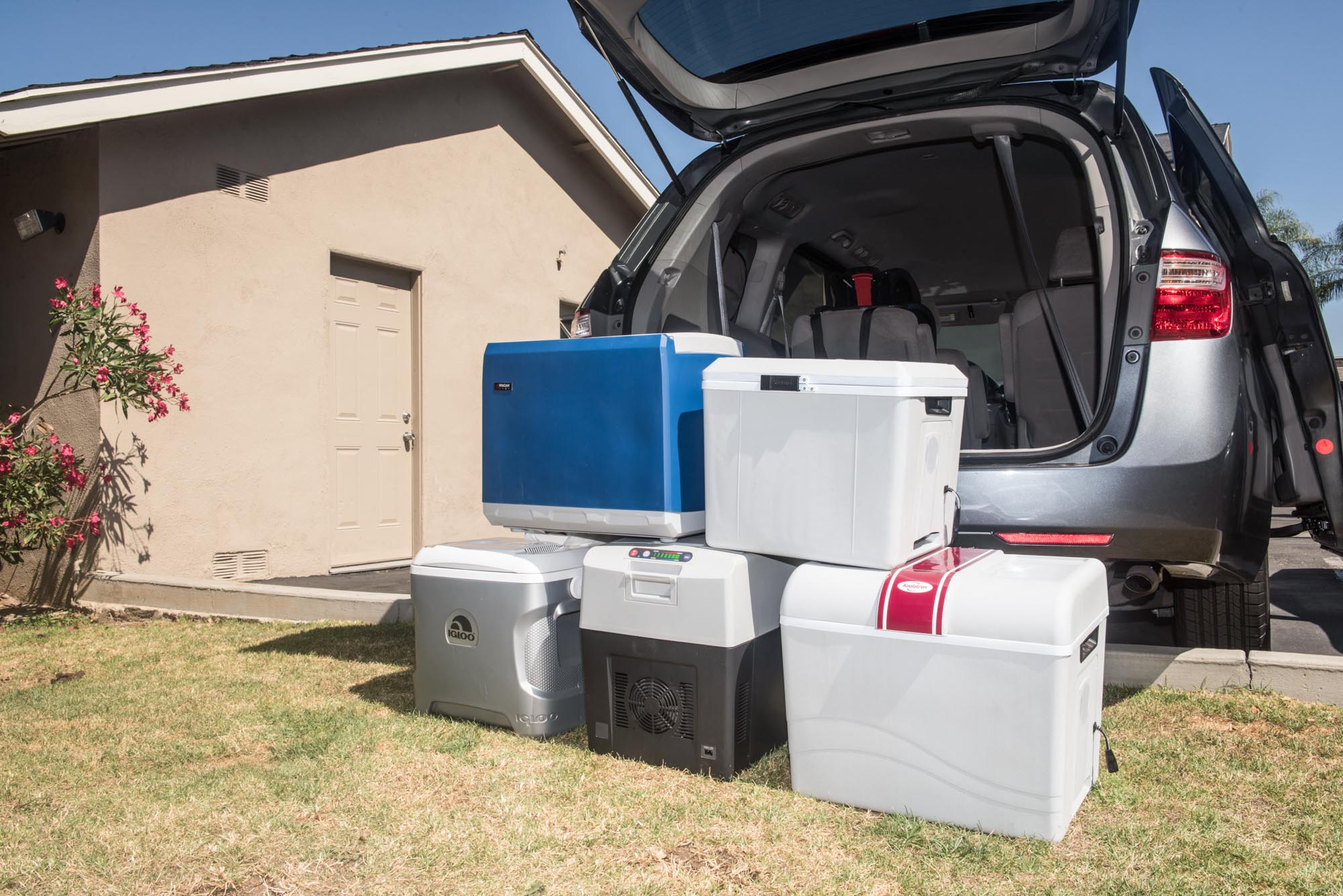
An electric cooler is a bit like the traditional insulated ice chest coolers that we’ve reviewed before, but it uses a thermoelectric “Peltier” device to move heat out of the cooler rather than absorbing it into ice.
The device itself seems almost too good to be true: Electricity carries heat from one side of a semiconductor pad to the other. Interestingly, that means if you reverse the polarity of the power cable, most of these coolers will turn into heaters.
These are usually advertised as “ice-free” coolers, and that’s how we used and tested them. You could add sealed gel ice packs to an electric cooler to help it absorb more heat, but dumping in a bag of ice can cause electrical shorts and isn’t recommended.
Limitations of electric coolers
There are two factors that limit the effectiveness of an electric cooler: the thermoelectric mechanism itself and the effectiveness of insulation.
The bigger the device and the more amperes of current you push through it, the more heat it can move. There are limits, though: Most thermoelectric systems can only change the temperature on one side by 30 or 40 degrees Fahrenheit.
There’s also the problem of getting rid of all that heat on the outside: All the models we tested use an aluminum heatsink and fan to dissipate the heat once it’s on the outside of the cooler. Better performance would require larger, more complex heat-dissipation systems.
Coolers for drinks and snacks have another major hurdle to overcome. Even when the cooler has good insulation, If you’re opening the lid constantly, the heat rushing in makes efficiency quite poor.
Power draw of electric coolers
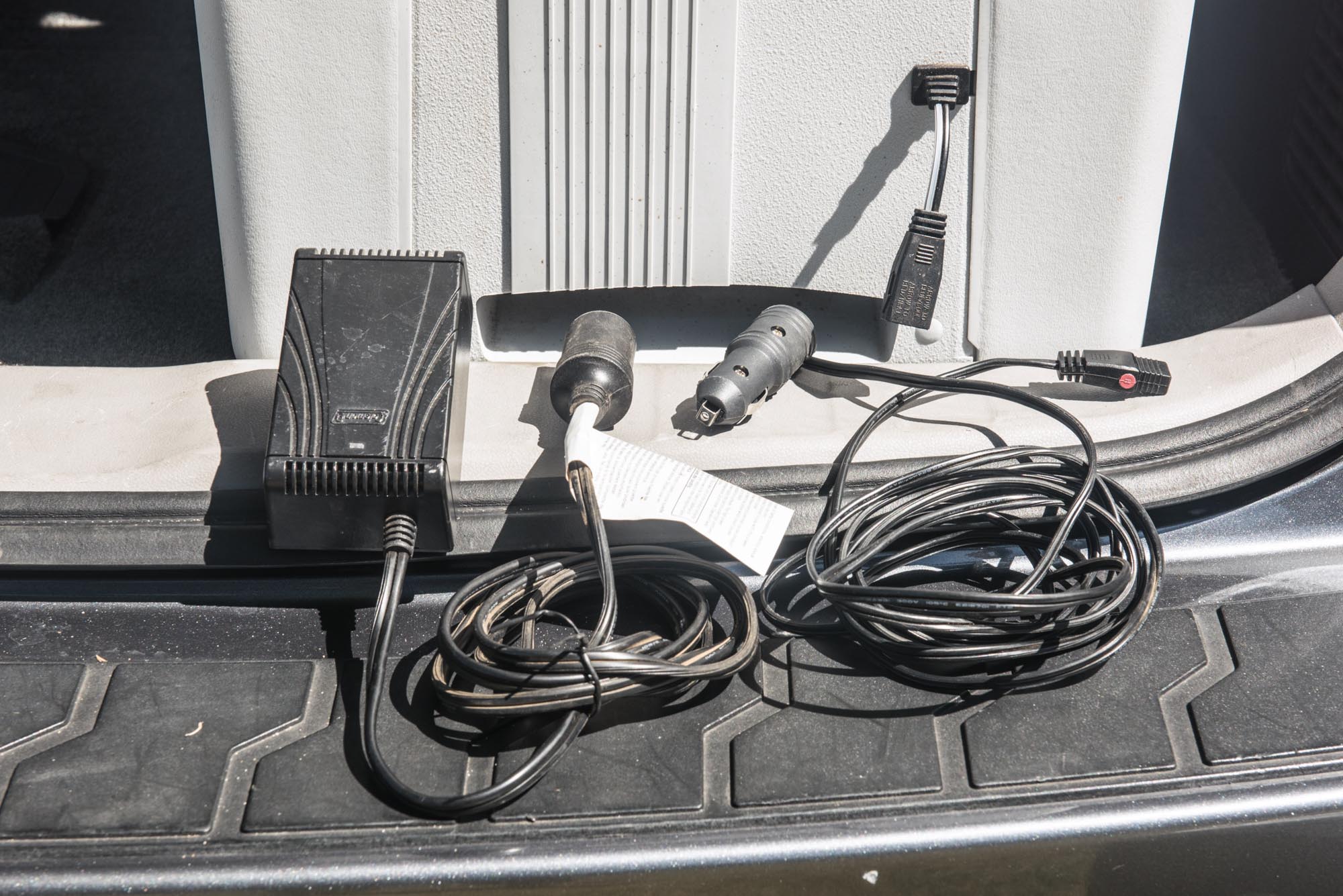
The coolers we tested are designed to only use 5 amps of 12-volt power, which is about the same draw as one headlight. That’s low enough that it won’t kill your battery over a short stop.
The battery for our tester’s Honda Odyssey minivan is rated for two hours of reserve capacity at 25 amps, so we could theoretically run one of these coolers for 8 hours before the battery would hit the bottom quarter of reserve life. You don’t ever want to go that low on the same battery you’re starting your vehicle with, though.
On a dedicated deep-cycle battery you can get away with more use, but most of us don’t have one of those in the car. These coolers are really only designed for active cooling while you’re driving or when you have access to a 120-volt AC outlet. (120-volt operation requires a separate adapter not included with most electric coolers.)
Pros and cons of electric coolers
Pros:
- Electric coolers don’t require making or buying ice to keep lunch and drinks cool (or hot) while you’re driving.
- No ice means no water soaking into your lunch.
- Thermoelectric coolers are far less expensive than compressor-type refrigerators.
- Fewer moving parts means that these coolers should be more reliable (or at least easier to repair) than refrigerators.
Cons:
- An electric cooler won’t chill enough to protect raw meat on a hot day.
- Most models aren’t as easy to clean as a good ice chest.
- A thermoelectric cooler needs to run constantly, so it actually drains your battery faster when parked than a 12-volt compact fridge would.
Ice chests vs. electric coolers
For the sizes that we tested, manufacturers rated the cooler performance at 40 degrees lower than the temperature outside the cooler, but that assumes a lot of things.
if you need to keep food (or anything else) below 40 degrees, you’d be better off using ice. When surrounded with ice, perishables are protected from heat for two or three days. So long as your food is in a waterproof container, even melted ice will typically keep food at safe temperatures for another day or so.
If you’re only keeping drinks chilled, or if you’re transporting something like medication that’s safe up to room temperature, an electric cooler will help you out without the constant re-stocking that makes ice inconvenient.
Adding frozen gel packs can help level the playing field between electric and regular coolers, but of course that still requires you to have access to a freezer.
Electric coolers vs refrigerators
The key advantage that a 12-volt refrigerator like this 50-watt model from Dometic has over a thermoelectric cooler is that it can keep your food cold even in extreme conditions.
Refrigerators use a coolant (like R-22, the modern replacement for Freon gas) that changes from liquid to gas inside a coiled metal tube. That process sucks all the heat out of your fridge very efficiently. A compressor makes that gas liquid again for another pass through the coil, and as the process repeats indefinitely, it can move an amazing amount of heat.
This phase-change system still works well on an incredibly hot day, but all those moving parts make a 12-volt fridge more expensive than a thermoelectric cooler.
Thermoelectric coolers will chill your drinks or help keep your lunch cold while your AC is on while you’re driving, but they need a constant supply of power. Reading user testimonials about real-world use of 12-volt fridges and freezers, it’s clear that the more expensive systems are more efficient at keeping things cold, but they still need extra battery capacity to be worthwhile.
Another big difference between an electric fridge and a thermoelectric cooler will be the built-in thermostat. A fridge cools quickly in short bursts to maintain a steady average temperature, while a thermoelectric cooler will need to run constantly and still not hit 40 degrees Fahrenheit on a hot day.
Important features to consider
Internal size: The size of a cooler is usually measured in quarts. The best way to keep food cool is to pack the cooler’s space full of pre-chilled or frozen beverages, so pick a size you’ll really use.
Shape: Most coolers are roughly box-shaped, but some are designed to fit in between front bucket seats if you have that configuration in your vehicle.
Door orientation: Coolers can be made to open upward, like an ice chest, or sideways, like a fridge. Some can work in both positions, but generally the top-opening models are the most versatile and popular.
Dividers and shelves: If you have food that should be stored at different temperatures, large full-featured coolers should come with slide-in pieces that will help you keep specific items closer to or farther away from the cooling element.
Power draw: Your vehicle’s battery has some reserve capacity, but you don’t want to risk getting stranded by using that all up. Higher power means better cooling power, though available models we looked at only differ by about 20 percent.
Thermostatic control: A built-in thermostat will turn a premium cooler on and off to try and maintain a set temperature. This will save power if you’re only using it in an air-conditioned car or on a cloudy day, but in a heat wave it’ll be running full-time anyhow.
Drain plug: This isn’t as critical a feature as it is for regular ice-filled coolers, but it still makes rinsing out an electric cooler much easier.
Heating mode: Most thermoelectric coolers can be switched from chilling to heating simply by reversing the polarity of the power plug, moving heat into the cooler instead of out. This is a nifty perk if you’re delivering lunches, but our test crew agreed that they’d rarely use it.
How we tested
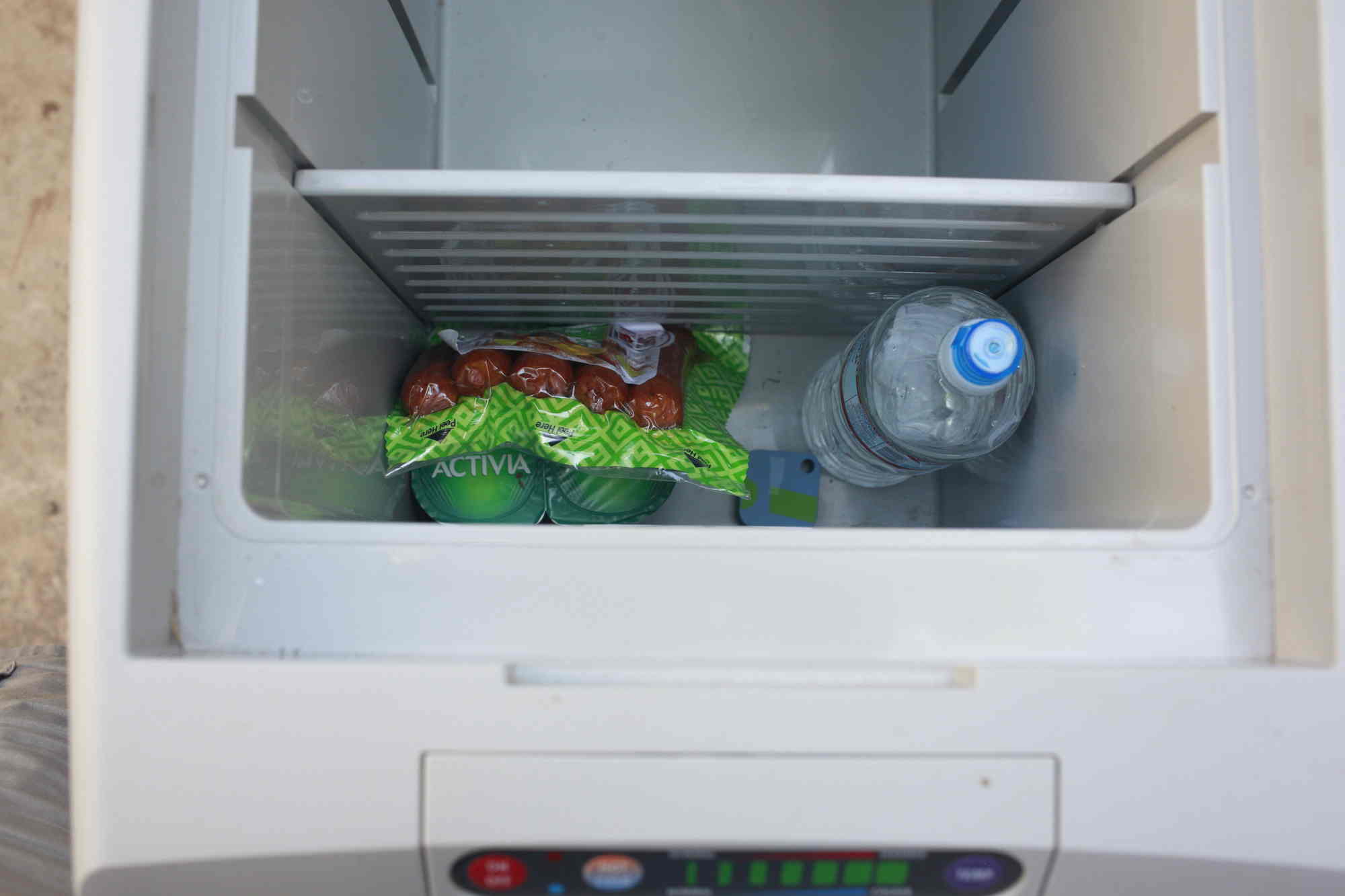
We set up our group of coolers on the patio for six days of 90-plus-degree weather. Each cooler was loaded with a pack of hot dogs, a pair of yogurt cups, and a water bottle. All items were refrigerated to about 40° F before we loaded up the coolers, but the coolers themselves had been sitting in 80° outdoor temperatures.
The coolers were running off of household electrical power for this test, which required the use of adapters not included with most coolers.
If you’re storing or transporting perishable food for more than a few hours, 40 degrees is the hottest temperature that will still stop bacteria from multiplying and keep your food safe.
We checked temperatures with an instant-read probe thermometer in the morning and afternoon, but we also tracked changes over the week with two SensorPush wIreless data-logging thermometers.
For a control, we loaded the top-ranked model from our review of the best coolers, the ORCA – 40 Quart Classic, with 20 pounds of ice and checked its temperature at the same time.
The first day of the test was overcast, with temperatures starting at 80 degrees and dropping to the mid 70s. This is close to the conditions inside the back of a car or truck, and the coolers did not perform as well as we’d hoped. After two hours, temperatures in most of the coolers stabilized at a mere fifteen degrees colder than outside air. The high starting temperature of the coolers just couldn’t be overcome by the thermoelectric systems.
As expected, the temperatures in the evening were much better, finally dropping down below 40 and even freezing in one unit when outside temperatures were in the 60s overnight. But that’s still not the performance necessary to keep perishable items like potato salad safe if you have to unplug when you’re stopped.
When we looked at the temperatures from the two data-log thermometers, it was clear that the insulation and cooling power of these coolers is insufficient for use outside on a hot day. As soon as the sun hit the spot they were sitting at around 10 a.m., the temperature would climb above 50 in a better cooler or all the way up to 70 in a cheaper cooler. Things only dropped again when outside temperatures fell below 70 overnight.
We weren’t expecting these coolers to perform well in the hot sun, but look at these results and think about what conditions you’ll actually be using your cooler in.
Ice and bear-proof insulation like you’ll find on the best coolers we’ve reviewed are still far superior to a small thermoelectric device when it comes to keeping the heat out of your food.
That goes double when you consider that ice doesn’t need electricity to do its job. A 120-volt adapter will help if you’ve got power hookups or a hotel room overnight, but that’s not usually an option if you’re camping.
The bottom line
After thoroughly testing these electric coolers side-by-side with our best-in-class ice-filled cooler, we’re fairly disappointed in all of them.
Despite claims that an electric cooler can get 40 degrees below ambient temperatures, we mostly saw temperatures that would quickly lead to spoiled food over the course of a long trip. You also need to supply 12-volt power constantly to keep things cold, or treat the electric cooler like a regular cooler and pack it with frozen items anyhow.
If you only need to keep pre-chilled food and drinks cold while you’re driving on long trips, the Koolatron – P27 Voyager is the top performer. This 29-quart model stayed coldest throughout our testing, and it’s a useful size for carrying picnic-sized meals.
If you’re looking for something a little bit bigger, the 46-quart Wagan – EL6244 has wheels, dividers and a drain feature that makes clean-up easier. It sacrifices cooling performance, but the price is also slightly lower.
More Reviews
Igloo - Playmate 30 Can
Thermos - 2700TRI6
Orca - 40 Quart Classic
The Best Beach Umbrellas, Chairs and Tents
Sport-brella
Garrett - Ace 250
Mac Sports - Heavy Duty
Superfeet - GREEN
The 7 Best Zero-Gravity Chairs
Timber Ridge
Thermos - Sipp
Wilson - Evolution
Mountain House - Just in Case


